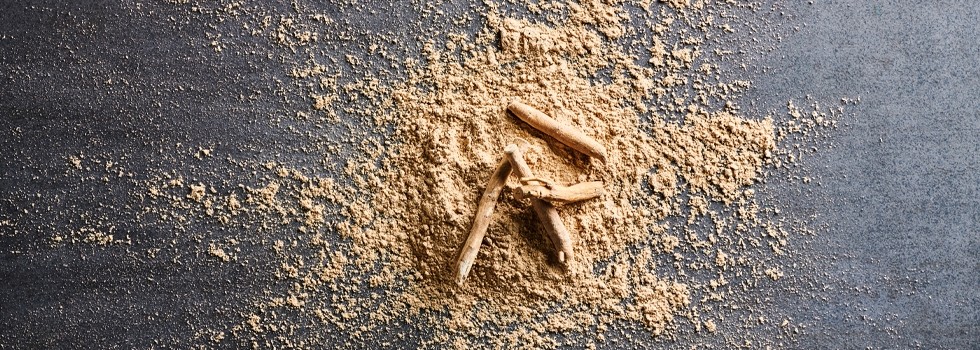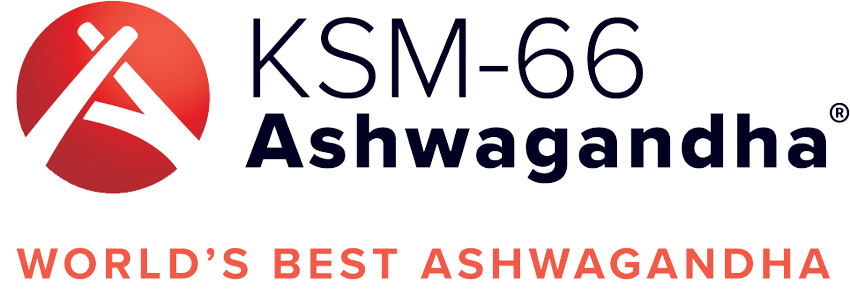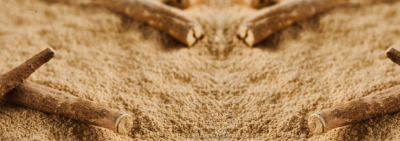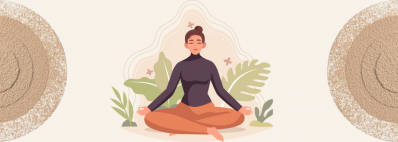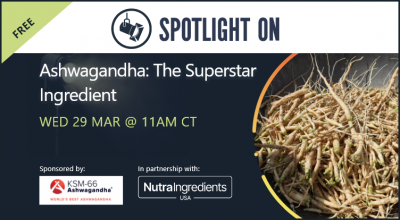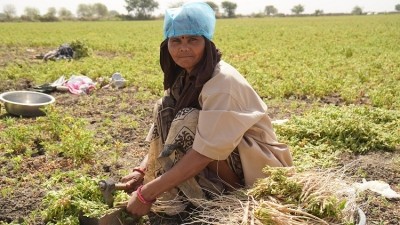Promotional Features
Considering Ashwagandha? 6 Reasons Why only Root is Best (Part II of III)
Ashwagandha (Withania somnifera) is enjoying consistent growth and an outstanding reputation as a powerful natural ingredient for promoting vigorous health and wellness.
For millennia, humankind has looked towards and benefitting from the traditional system of medicine – Ayurveda, Unani and Siddha - to lead healthy lives. All three systems of medicine have recognized the roots of Ashwagandha as the effective nucleus of various preparations. This recognition has been made across various Southeast Asian countries -- India, Bangladesh, Malaysia, Singapore, Nepal, Bhutan, Pakistan and Sri Lanka. Ashwagandha roots also known as “amukkara” and “asgand” in Siddha and Unani respectively is a well-known aphrodisiac that helps in in improving sexual function [1-3].
When considering formulations featuring ashwagandha, it is critical to use only root material, as this is the part of the Ashwagandha plant that provides its wide-ranging potent abilities – as shown by a large, growing research portfolio. And there is one supreme ashwagandha root extract – KSM-66, which continues to dominate the market for six key reasons.
Our previous article introduced the concept of six powerful reasons as to why only the roots of Ashwagandha should be used over any other part of the plant, and discussed in detail the first two:
1. Traditional use
2. Modern research
Now we will present two other attractive reasons to select ashwagandha roots:
3. Global regulatory approvals
4. Global pharmacopeia recommendations
Global Regulatory Approvals
The global market for supplements and herbal medicine products is expanding, providing new industry and product growth opportunities for both producers and manufacturers. Successfully tapping this market, however, requires an understanding of the global regulatory frameworks, their potentials, and pitfalls. Here is a synopsis of the regulatory scenarios throughout the world.
Canada: In Canada, ashwagandha root is listed as an active ingredient in approved natural health products (NHPs), which necessitates pre-marketing approval from the Natural Health Products Directorate (NHPD) and manufacturing in accordance with NHP Good Manufacturing Practices (GMPs) [4].
Europe: European Medicines Agency (EMA) has an ongoing case making a monograph for Withania somnifera. What’s key here is that the EMA is using only the root in its work to compose a monograph for use as a traditional herbal medicine. [5]. Also in Europe, the European Food Safety Authority (EFSA), allows a total of 11 health claims for ashwagandha, and all of those can be used for the roots of the plant. However, leaves can make only 2 claims out of the 11. Specifically, roots can make the following general claims: antioxidant activity, adaptogenic activity, reproduction, rejuvenation, respiration, energy, mental, stress & sleep, skin, cardiovascular health and cognitive health. However, using leaves are restricted only to claims for mental health and cardiovascular health. A couple of countries in Europe have only the root of the Ashwagandha on the positive list of approved botanicals.
India: The Government of India, Department of Ayurveda, Yoga & Naturopathy, Unani, Siddha and Homoeopathy (AYUSH), prioritized the promotion of Ashwagandha preparations for attaining marketing authorizations as medicinal products in several foreign markets including selected EU member states, as well as in Australia, Canada, and Commonwealth of Independent States (CIS) countries — as part of a global strategy for brand-building of Ayurvedic medicine. This Ashwagandha strategy, begun in 2008, was developed in collaboration with the International Trade Centre (ITC) of United Nations Conference on Trade and Development UNCTAD (Geneva, Switzerland) [6].
Global Pharmacopeia Recommendations
To reiterate our previous article, Ashwagandha root is predominantly used as per both thousands of years of traditional use and independent clinical trials. In compliance with this, the canonical definition and description of Ashwagandha in reference works such as pharmacopeias focus solely on the root.
There are standards monographs published on Ashwagandha (Withania somnifera) in the Ayurvedic Pharmacopoeia of India (Vol. I, 1989), the World Health Organization (WHO) Monographs (Vol. 4, 2009), British Pharmacopoeia (BP 2012), Indian Pharmacopoeia (IP 2010), and United States Pharmacopeia (USP 36).
- The United States Pharmacopoeia (USP) has developed dietary supplement quality standards monographs for “Ashwagandha Root,” “Powdered Ashwagandha Root,” and for “Powdered Ashwagandha Root Extract.”
- In 2010, the British Pharmacopoeia (BP) had established a monograph of quality standards for the dried mature root of Withania somnifera, specifically for use in Traditional Herbal Medicinal Products (THMPs), as specified by the EU Traditional Herbal Medicinal Products Directive (THMPD).
- Health Canada has developed a standard monograph on Ashwagandha root.
- The Indian Pharmacopeia has developed quality standard monographs on Ashwagandha that consists of the dried mature roots of Withania somnifera (L.) Dunal (Fam. Solanaceae) and Ashwagandha Dry Extract, that is obtained by extracting Ashwagandha (Withania somnifera (L.) Dunal, Fam. Solanaceae) roots with methanol or any other suitable solvent and evaporation of the solvent.
- The WHO monograph on Ashwagandha is also on the dried roots of Withania somnifera.
- A standard monograph on Ashwagandha root is included in The Ayurvedic Pharmacopeia of India.
- The Siddha Pharmacopeia of India has developed a monograph on Amukkara root ie., Ashwagandha root.
- The American Herbal Pharmacopeia has developed a monograph on Ashwagandha root (Withania somnifera): Analytical, Quality Control and Therapeutics.
Note: Ashwagandha leaf is not listed in any of these monographs for any therapeutic purposes. The fact that expert opinion prefers the root over the leaves is mirrored in these reference works.
Conclusion
Worldwide regulatory support and pharmacopeial acknowledgment of Ashwagandha root strengthen and solidify the reasoning for its use in supplement, beverage and food formulations to create desirable health responses.
Part 3 of 3 will discuss reasons 5 and 6 that support the use of the roots of Ashwagandha: Market potential, and Economic adulteration.
--------
References:
- Ayurvedic Pharmacopoeia Committee. Asvagandha. In: The Ayurvedic Pharmacopoeia of India, Part I, Volume I. New Delhi, India: Government of India, Ministry of Health and Family Welfare, Department of Ayurveda, Yoga & Naturopathy, Unani, Siddha and Homoeopathy (AYUSH). 1989.
- Unani Pharmacopoeia Committee. The Unani Pharmacopoeia of India, Part I, Volume I, New Delhi, India: Government of India, Ministry of Health and Family Welfare, Department of Ayurveda, Yoga & Naturopathy, Unani, Siddha and Homoe- opathy (AYUSH). 2007;7-8.
- Siddha Pharmacopoeia Committee. Appendix 5.2 Cutti (Purification) of crude drugs. In: Siddha Pharmacopoeia of India, Part I, Vol. I, First Edition. New Delhi, India: Govt. of India, Department of Ayurveda, Yoga & Naturopathy, Unani, Siddha and Homoeopathy (AYUSH). 2008;278-281.
- Natural Health Products Directorate (NHPD). Monograph: Ashwagandha. Ottawa, Ontario: NHPD. April 18, 2007. Available at: http://webprod.hc-sc.gc.ca/nhpid-bdipsn/ monoReq.do?id=35&lang=eng. Accessed July 4, 2013.
- European Commission Health & Consumers Directorate. Novel Food Catalogue. Brussels, Belgium: European Commission. Available at: https://www.ema.europa.eu/en/medicines/herbal/withaniae-somniferae-radix#overview-section
- Basant S. Support to sustainable export development of Indian Ayurveda products [Letter to Josef Brinckmann, ITC Consultant]. New Delhi, India: Govt. of India, Ministry of Health and Family Welfare, Department of AYUSH. July 16, 2008.
- United States Pharmacopeia Convention. Ashwagandha Root; Powdered Ashwagandha Root; and Powdered Ashwagandha Root Extract. In: United States Pharmacopeia, 36th Revision (USP 36). Rockville, MD: United States Pharmacopeial Convention. 2013;1336-1341.
- Siddha Pharmacopoeia Committee. Appendix 5.2 Cutti Purification) of crude drugs. In: Siddha Pharmacopoeia of India, Part I, Vol. I, First Edition. New Delhi, India: Govt. of India, Department of Ayurveda, Yoga & Naturopathy, Unani, Siddha and Homoeopathy (AYUSH). 2008;278-281
